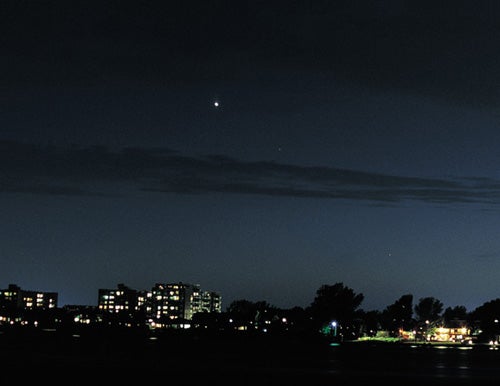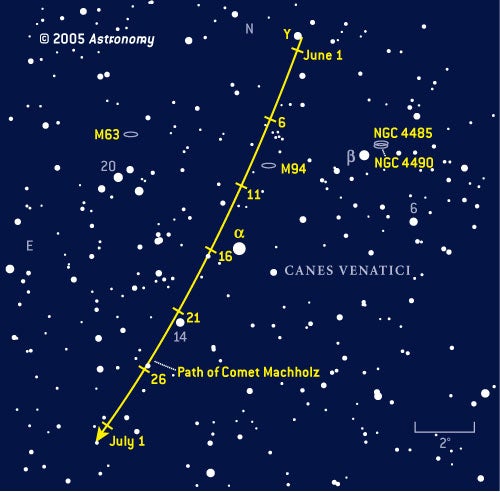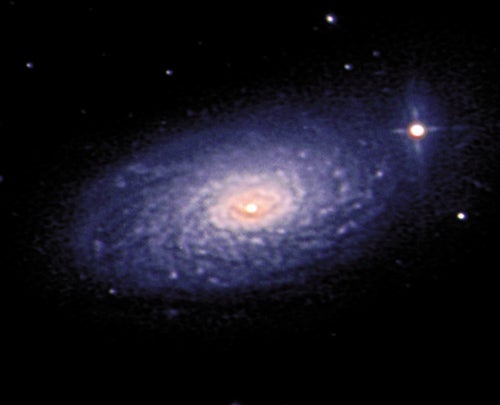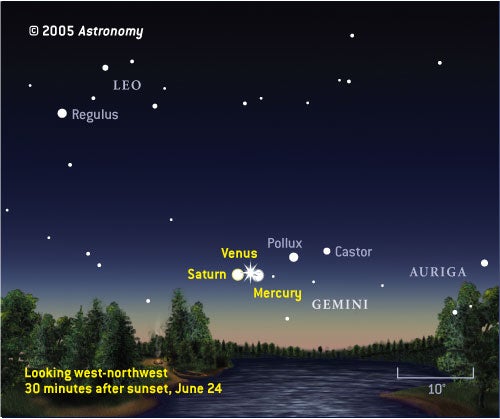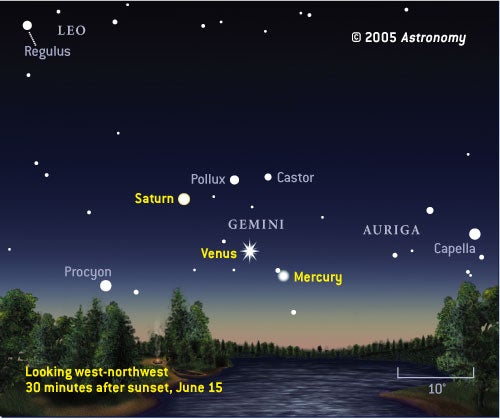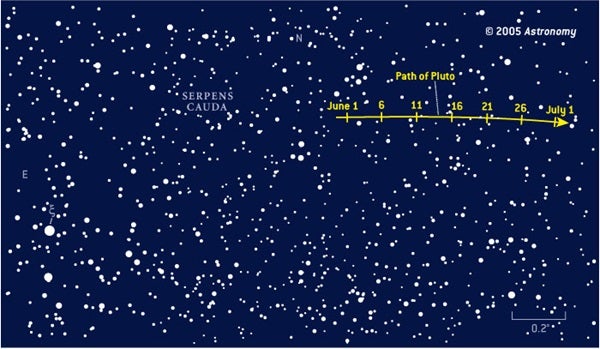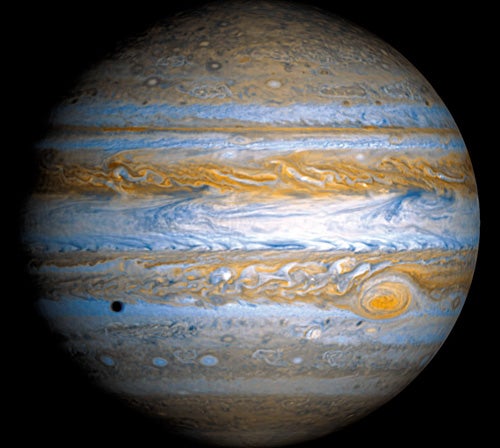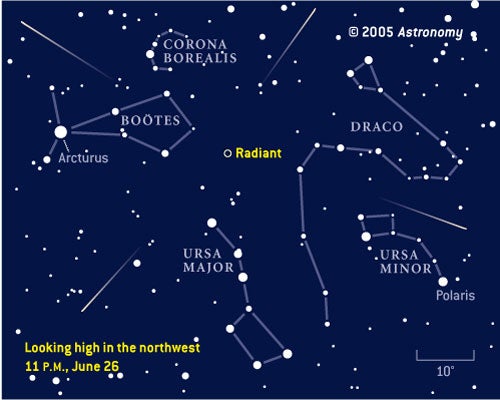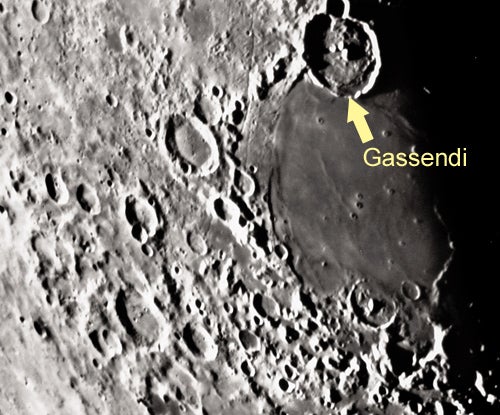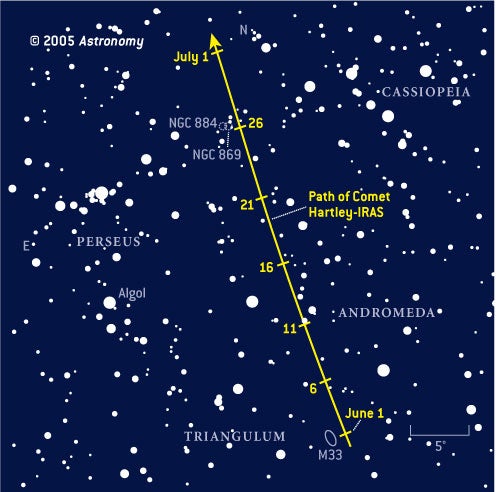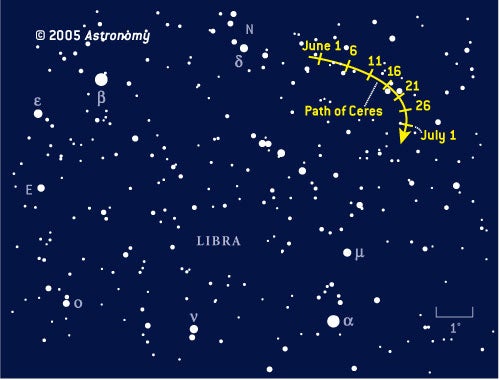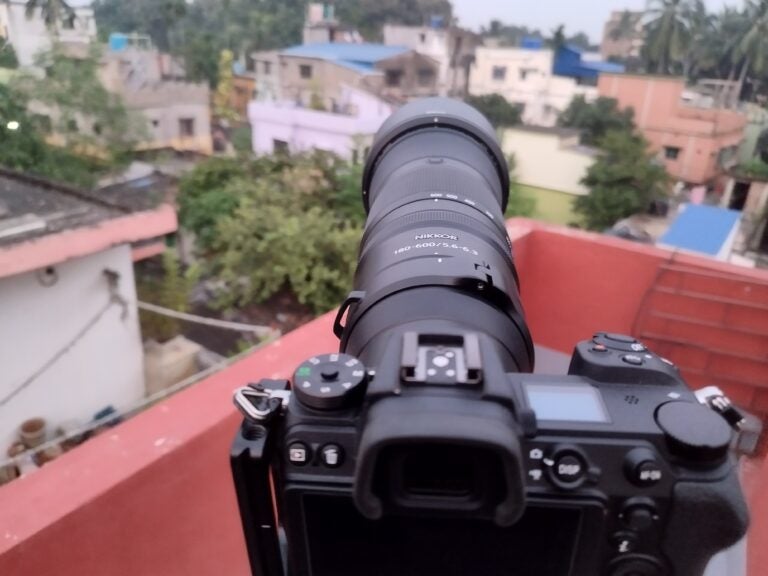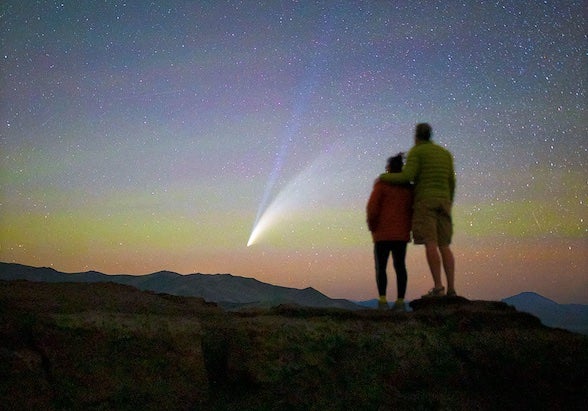The best way to find Venus during daylight is with a go-to telescope. This avoids the risk of accidentally pointing your scope at the Sun, which will cause irreversible eye damage. If you don’t own a go-to scope, it’s better to wait until after sunset and view the planets when they lie slightly farther apart. The tilt of Earth’s axis this month brings the Northern Hemisphere its summer solstice and also causes these planets to be low in the evening sky. You may need binoculars to spy them 30 to 45 minutes after sunset.
This is the final conjunction in a series of five that began last December. The two inner planets haven’t appeared this close since 1990.
If you want a last look at Saturn before it disappears behind the Sun for a couple of months, you must locate it before the sky grows completely dark. Turbulence in Earth’s atmosphere will degrade the view through a telescope with each passing minute. Late in the month, Saturn joins the dancing duo of Mercury and Venus.
You can practice your daytime search skills June 15 and 16, when Jupiter lies near the First Quarter Moon. From North America on the 15th, the planet appears 8 lunar diameters from the Moon in the 9-o’clock position relative to the lunar terminator (the straight line that divides light from dark). The next day, Jupiter lies 9° (almost the width of a fist at arm’s length) away between the 2- and 3-o’clock positions. First find the planet with binoculars, then, if the sky is a transparent, deep blue, try to spot it with your naked eye.
Where’s Mars? It’s been nearly 2 years since its last close approach. Earth is still playing catch-up in the planets’ orbital race, which leaves the Red Planet rising in the east just before 2 a.m. local daylight time. Some tired all-night observers might mistake it for a nova — a star that has a massive outburst. The excitement will wane quickly with a telescopic look because Mars presents a fairly small, bland disk. In just 5 months, however, the planet will treat us to some exceptional views.
Winter’s bright Comet C/2004 Q2 (Machholz) continues to be a nice target from rural locations. Follow its trek southward below the Big Dipper, using it as a guide to deep-sky objects in Canes Venatici. Another comet, 9P/Tempel 1, literally becomes a target next month when NASA slams a projectile into it (see “Fireworks on the Fourth” on page 68). By making before-and-after observations, you can witness history.
Two more comets patrol the morning sky. One of them, Comet 161P/Hartley-IRAS, provides imagers with two nice photo opportunities. First, it grazes the Pinwheel Galaxy (M33) in Triangulum. Then, it skirts the Double Cluster in Perseus.
Hunting for stars
In 1690, Johannes Hevelius introduced the constellation Canes Venatici, the hunting dogs of Boötes the Herdsman. The dog Chara lies to the west and is centered around Beta (β) Canum Venaticorum, while Alpha (α) CVn represents the canine Asterion.
If you want color, check out Y CVn, better know as “La Superba.” Its prominent orange hue is a dead giveaway for a variable star. As the star fades and cools, the color shifts more to red, just like a fire’s embers.
On the night of May 31, Comet C/2004 Q2 (Machholz) nearly occults La Superba. The star then glows around magnitude 9.5 and is fading slowly.
Because comets are extended, diffuse objects, the best views come from locations far from the city. On the New Moon weekend of June 4 and 5, take the time to focus on the comet and compare it with the nearby spiral galaxy Messier 94. Both objects have bright, nearly stellar cores and round halos. But M94 appears perfectly symmetrical, while Machholz shows one side more sharply defined than the other.
A very different sight awaits just west of Beta CVn. NGC 4485 and NGC 4490 form a pair of interacting galaxies. Long ago, the two passed close to each other, ripping off a stream of gas and dust. Now, new stars are igniting there at a furious pace. Although you won’t see this level of detail at the eyepiece, you may detect hints of something different going on. Rather than having starlike nuclei, the galaxies appear more diffuse. The fainter one, NGC 4485, is fairly tough to see through a 6-inch scope.
One attraction of deep-sky observing is the voyage of imagination it launches within us. The faint smudge in the eyepiece is only the beginning. Knowing what’s happening there is what makes observing exciting. A faint blip could be
a supernova, a quasar, or a starburst region. Two hundred years ago, astronomers were reeling with the concept of a universe 100,000 light-years across — mere puddle-jumping for today’s amateurs.
If you want to see all nine planets, you need to start right after sunset. Mercury, Venus, and Saturn congregate in the early evening sky. During a spectacular conjunction in late June, all three lie within an area no larger than 4 Moon-widths. Each night, their relative positions change.
A slim crescent Moon joins the action at the end of June’s first week. New Moon occurs June 6, so look the following night for a slim crescent to the lower right of Venus. You may need binoculars to spot our satellite against the twilight.
June 8 finds a clearly visible crescent Moon 6° above Venus. The next evening, the Moon slides between Saturn and Pollux, creating a distinctive line of four objects when you include Castor. Well below this quartet, Venus punctuates the horizon with its brilliant glow.
Venus continues its climb toward Saturn during the second week of June. By June 13, keen-eyed observers might notice Mercury to the lower right of Venus. Each succeeding evening, Mercury becomes easier to spot as it, too, climbs away from the twilight glow. Its rapid motion will have it catching up with Venus shortly.
On the 21st, Mercury and Venus stand 2° apart, just below Pollux, with Saturn to their upper left. Venus shines brightest at magnitude –3.7, then comes Mercury at –0.5 and Saturn at 0.2.
As Mercury ascends each evening, it appears slightly fainter but in a darker sky. By June 24, it lies within 1° of Venus and remains there through July 1. The two inner planets appear closest June 27, when they stand only a few arcminutes apart. They can be viewed together in the same telescopic field of view. Venus appears 11″ across and shows a 91-percent-illuminated disk, contrasting nicely with Mercury’s 7″-diameter disk and 60-percent-lit phase.
That same evening, Saturn lies to the lower right of the Mercury-Venus pair. Over the final few June evenings, the ringed planet descends into the twilight along with Castor and Pollux. Meanwhile, Mercury and Venus continue their dance upward through Cancer the Crab.
Jupiter shines at magnitude –2.1 and spans 39″ during June. Given the warm nights and the planet’s reasonably high evening altitude, June is ideal for viewing the atmospheric features that parade across Jupiter’s disk. The most prominent features visible through backyard scopes are the two dark equatorial belts that run on either side of the planet’s equator. There, on the boundaries of these rapidly rotating regions, you can see the most detail. These features tend to disappear and then return to view as Earth’s atmosphere generates turbulence. The fuzzy image in the eyepiece typically steadies for fleeting moments.
After midnight, as Jupiter approaches the western horizon, Sagittarius and Scorpius lie due south. Directly above the tail of Scorpius is sprawling Ophiuchus and its neighbor to the southeast, Serpens Cauda. Pluto lurks in the southwestern corner of this constellation, near the star Xi (ξ) Serpentis. The elusive planet lies opposite the Sun in our sky June 14, marking the best time of the year to hunt for it. Pluto glows dimly at magnitude 13.8, which means you’ll need an 8-inch telescope to see it. And the more aperture you have, the better your chances.
Fortunately, the presence of 3.5-magnitude Xi Ser aids your search. At opposition, Pluto lies just 1.5° west-northwest of Xi. The finder chart (above right) shows stars down to magnitude 14.0, so you should be able to pick out which dot is Pluto. If not, sketch the stars you see in your telescope’s field of view and return to the same region a night or 2 later. The “star” that has moved is Pluto.
After nabbing Pluto, cast your gaze eastward toward Capricornus, the current home of Neptune. Compared with Pluto, Neptune is easy to spot. Glowing at magnitude 7.9, you’ll find it 4° northeast of Theta (θ) Capricorni, the 4th-magnitude star in the north-central part of the constellation. To locate Neptune, find Iota (ι) Cap 4° east of Theta. A 5.3-magnitude star, 29 Cap lies just 2.3° northwest of Iota. Neptune spends June roughly midway between these two stars. A couple of stars brighter than Neptune lie in the same area, so be careful identifying the planet. The best way to confirm a sighting is to aim a scope in its direction. Neptune reveals its planetary status by showing a small, blue-gray disk, which measures 2.3″ across.
Farther east lies Aquarius, the constellation where Uranus currently resides. This region rises around 1 a.m. local daylight time in mid-June. Uranus proves easier to see than Neptune because it’s about 7 times brighter, glowing at magnitude 5.8. Although this brings it within naked-eye range, binoculars give you a better chance to spy it.
Mars, the eighth planet on view these June nights, rises about an hour after Uranus. By the break of dawn, the Red Planet stands 25° high in the east-southeast. As June closes, Mars reaches magnitude 0.0, easily the brightest object in this part of the sky except for the Moon. A waning crescent Moon passes near Mars during the final three June mornings.
Mars becomes a respectable target for telescope owners by month’s end, when it reaches an angular diameter of 9″. By the time it reaches opposition in November, Mars will more than double in apparent size.
The ninth and final planet has been there all night long. Simply look past your shoes to see our home planet, Earth.
Summer showers
The Ophiuchid meteor shower ranks among the minor showers visible throughout the year. Although best seen from southern latitudes, northerners occasionally see an Ophiuchid streak across the early-summer sky. The shower features multiple radiants that rise fairly high in the south around midnight. Rates, unfortunately, rarely climb higher than 5 meteors per hour.
Although no big return is expected this year, it’s worth keeping an eye open. Observing conditions this month should be good: The radiant lies high in the evening sky, and dark skies prevail until the Moon rises a bit after midnight June 26/27.
Few craters on the Moon can compare with Gassendi. It lies on the northern shore of Mare Humorum, in the southwestern quadrant of the Moon. Several geologically attractive features await observers of this prominent crater. The best views of Gassendi come as the Sun rises over the region. This occurs around 11 days after New Moon, so plan to look June 17 and 18 this month.
A complex central mountain range lies amid a crisscrossing network of rilles that spans Gassendi’s floor. A prominent rille runs from the eastern wall to the southwest, while another connects the crater’s eastern side to the central mountain range. A small telescope will show both these rilles under good seeing. Larger scopes reveal finer rilles and smaller secondary craters dotting the main crater’s floor.
Notice how the terrain changes at the southern end of Gassendi, where lava has partially flooded the inner crater. The rest of the crater floor is hilly and rough, and thus much older than the lava-filled section to the south.
This indicates two separate events transpired here — the upwelling of lava from Mare Humorum happened much later than the impact that created the crater.
Comet cornucopia
Every now and then, we have two nice comets to compare. It’s rare to have four within range of a 4-inch scope on one night, but that’s the case in June. The most interesting one has to be 9P/Tempel 1 because NASA will wallop this comet with a heavy probe in early July. (See “Fireworks on the Fourth” on page 68.)
If you went to the country to view Machholz at its peak in January, you know how much better it looked — with a longer and more obvious tail — than from the city. Urban light pollution fills the background sky with a cloak that hides subtle and faint features, and sometimes even entire comets, if you use a small scope. All of June’s comets will be much easier to see from a dark site.
Getting the most out of shorter June nights means staying up until 3 a.m. local daylight time. By then, two more comets have risen in the northeast: 161P/Hartley-IRAS and 21P/Giacobini-Zinner. Glowing at 10th and 9th magnitude, respectively, these periodic comets will look similar to Machholz.
Hartley-IRAS passes within a degree of the large Pinwheel Galaxy (M33) in early June. This famous spiral has a low surface brightness that rewards patient observers with views of numerous knots, which are actually giant stellar nurseries like the Orion Nebula. By far, the easiest of these to see is NGC 604, northeast of the galaxy’s center. A nice photo opportunity occurs at midnight June 29/30, when Hartley-IRAS skims just west of NGC 869, one-half of the famed Double Cluster.
A rock among gems
Brighter objects aren’t always easier to find. The asteroid 2 Pallas currently glows at 9th magnitude just north of the galaxy M85 in Coma Berenices. Most of the stars here are faint and widely spaced. Although bigger and brighter, at magnitude 7.4 in early June, asteroid 1 Ceres may be harder to spot because it lies in front of the more crowded star fields of Libra. It may not be obvious to the naked eye, but a telescope will reveal the ever-increasing number of stars as you sweep toward the central bulge of the Milky Way Galaxy.
When William Herschel coined the name “asteroid,” which literally means “starlike,” he wasn’t kidding. A good look at the area north of Alpha (α) Librae and west of Beta (β) Lib will confirm that an asteroid is easily camouflaged by similarly bright stars. Use the chart above to zoom in on Ceres’ position. Otherwise, you’ll have to confirm your sighting over a couple of evenings. The asteroid’s shift from one night to the next will betray the stellar imposter. Make a quick sketch of the brighter stars in the area, then come back a night or two later to see which one moved.

